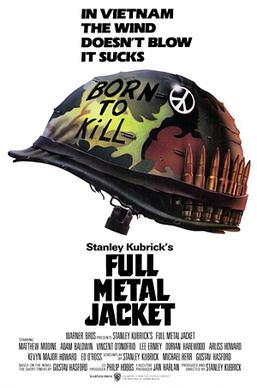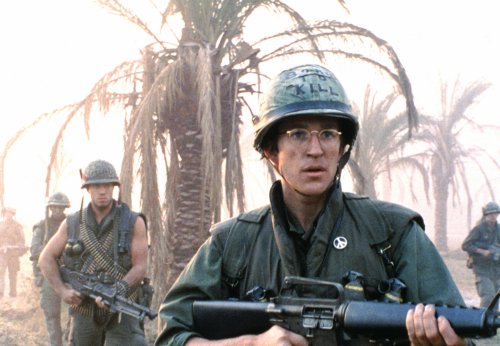 #793- Full Metal Jacket (1987)
#793- Full Metal Jacket (1987)Starring: Matthew Modine, Vincent D'Onofrio, R. Lee Ermey
Directed by: Stanley Kubrick
Plot Summary: During the Vietnam War, new recruits arrive to train for the U.S. Marine Corps. After arriving, they meet their drill instructor Sgt. Hartman, who begins to interrogate and harass the trainees in order to give them nicknames. Two that really stand out are Private James Davis, who earned the name "Joker" with his humorous tendencies, and Private Leonard Lawrence, who earned the name "Gomer Pyle" for his bumbling and clumsy behavior. After getting the recruits in trouble multiple times for his foolishness, Hartman assigns Joker to train Pyle into becoming a weapon of warfare. But is there a price for being trained into being a soldier, born to kill anything and everything on the opposing side of war?
I've started to notice as we get to the tail end of Stanley Kubrick's career, we venture into the movies I wanted to review the most. Already, I have gone way up in my ratings scale for films like A Clockwork Orange and The Shining, declaring them as instant favorites. So when it was time to sit down and watch Full Metal Jacket, I was really looking forward to it. Combining his string of success in the modern world of film and mixing it with the anti-war themes present in his earlier classics like Paths of Glory and Dr. Strangelove, I knew I was in for something great. And I wasn't wrong, well, at least not entirely. Full Metal Jacket was a terrific movie that I couldn't take my eyes off of, but I also acknowledged that it felt like two mini-movies put in one, which instantly created the debate on if the two movies fit together as a whole, or if there was one half that stood out more than the other. Well, considering that I had already split it into two halves, you should be able to figure that answer out.
 I'm sure if you've heard of this movie, there are two characters I'm sure most of you think about, yet our main character is probably not one of them. Matthew Modine stars as Private Joker. Joker knows how to follow that line between cracking jokes and taking things seriously. He certainly has a mentality that allows him to fit in during training, which includes him being promoted and being considered a team leader and trainer. One of the things I found most interesting with Joker is that he claims he was born to kill (it even says so on his helmet), yet when it's time to get stationed in the war, he requests to be a journalist and even sports a peace button on his vest, which of course sends tons of mixed signals and themes that are open for interpretation. Honestly, I really liked Joker as a character, but of course it's difficult for him to stand out when he has to go against two VERY iconic side characters.
I'm sure if you've heard of this movie, there are two characters I'm sure most of you think about, yet our main character is probably not one of them. Matthew Modine stars as Private Joker. Joker knows how to follow that line between cracking jokes and taking things seriously. He certainly has a mentality that allows him to fit in during training, which includes him being promoted and being considered a team leader and trainer. One of the things I found most interesting with Joker is that he claims he was born to kill (it even says so on his helmet), yet when it's time to get stationed in the war, he requests to be a journalist and even sports a peace button on his vest, which of course sends tons of mixed signals and themes that are open for interpretation. Honestly, I really liked Joker as a character, but of course it's difficult for him to stand out when he has to go against two VERY iconic side characters.I'm sure a lot of people when they think of this movie think of R. Lee Ermey yelling at the top of his lungs as Sgt. Hartman, and it's really easy to understand why. Ermey, an actual former drill instructor in the Vietnam War, was said to be too soft by Kubrick to bring the grittiness of Hartman to the big screen. Feeling challenged, Ermey decided to ad lib insults in a method for auditioning for the part. Safe to say Kubrick was impressed, and proceeded to cast Ermey as one of the most iconic characters Kubrick has ever brought to film. This man spouts out insults and swear words on a legendary status, and whenever I think of the phrase "drill instructor," the first thing I think of is Hartman yelling in my face.....now there's some nightmare fuel for a while.
Hartman's biggest (no pun intended) punching bag in the movie is Private Pyle, played by Vincent D'Onofrio. You wanna talk about dedication to a role? In order to play Pyle, D'Onofrio had to gain 70 pounds. I really believe he is one of the most sympathetic characters I've seen in a Kubrick movie. He's sort of that window for the audience to see what training for the Marines is like. You can tell he wants to be there, serve his country, be recognized for something great, but he lacks the skills like strength, stamina, and intelligence to do so. You can really feel for someone like that. Of course, if you were in there with him and being punished for his mistakes, you wouldn't feel the same way. Then, when he starts to become better, he slowly begins to lose his sanity and humanity, which causes the viewer to feel even worse for him. Sure, he becomes a weapon of war, but at what cost? And that's why Pyle is such a compelling character: he starts as a person viewers would live through and feel sorry for, and then becomes a symbol for one of the movie's greatest themes.
 The first half of the movie looks at the Marine training. This includes the great scenes with Hartman and Pyle, but other than that, there is some great camera work (broken record much?) that lets the rooms they're in stretch out and creates a very surreal room-stretching perspective for the viewer. Add to the fact that Joker is the main character caught up in all this chaos, and you have a recipe for a very great first half of the movie. In fact, had the movie ended at this point, and only been a 40 to 50 minute short film of JUST THIS PART, it could have been my favorite film from Kubrick. Oh yeah, it's THAT good. It reminded me a lot of how much I enjoyed Whiplash (which by the way, if you haven't seen Whiplash yet, GO FREAKING WATCH IT!), which was another film with a short-film narrative but made the most of the space it had and capitalized on the raw and powerful performances of its main characters. If it had ended here, I wouldn't have had a problem with that decision at all, but since the story continues, the second half has quite the act to follow...
The first half of the movie looks at the Marine training. This includes the great scenes with Hartman and Pyle, but other than that, there is some great camera work (broken record much?) that lets the rooms they're in stretch out and creates a very surreal room-stretching perspective for the viewer. Add to the fact that Joker is the main character caught up in all this chaos, and you have a recipe for a very great first half of the movie. In fact, had the movie ended at this point, and only been a 40 to 50 minute short film of JUST THIS PART, it could have been my favorite film from Kubrick. Oh yeah, it's THAT good. It reminded me a lot of how much I enjoyed Whiplash (which by the way, if you haven't seen Whiplash yet, GO FREAKING WATCH IT!), which was another film with a short-film narrative but made the most of the space it had and capitalized on the raw and powerful performances of its main characters. If it had ended here, I wouldn't have had a problem with that decision at all, but since the story continues, the second half has quite the act to follow...The second half of the movie isn't bad. In fact, it's very visually stunning for Kubrick (are you tired of hearing that yet?), and definitely soaks up the atmosphere of what it would look like to be in the Vietnam War, so why did I like it less? Honestly, part of it probably had to do with the fact that we were thrust into an environment with Joker and all new characters. There are certainly a few that stand out, but a lot of them are bland, and considering the first half was highlighted by Hartman and Pyle, it's easy to see why many would consider the second half inferior by comparison. Still, the second half is Joker's part of the movie, and the anti-war themes are present, but I think Kubrick's direction is most effective when he takes so little and makes the most of it. The grander his scale gets in trying to create an epic movie, the less interested I am (see Spartacus, 2001: A Space Odyssey, and Barry Lyndon), and the second half of Full Metal Jacket tread a very fine line. If that first half hadn't been as effective as it was, I probably wouldn't have liked this film as much as I did. In that respect, I'm willing to combine the two parts into one complete narrative that gave me a film I thoroughly enjoyed.
Rating: 4 out of 5 stars
Both halves of Full Metal Jacket are really well done, but if I had to say one side I enjoyed more than the other it would obviously be the first half thanks to the performances from Ermey and D'Onofrio. The language and anti-war themes may be a little tough to stomach for the casual moviegoer, but movie buffs everywhere should enjoy checking this one out, so I recommend adding this Kubrick classic to your collection.
Full Metal Jacket and movie images are copyrighted by Warner Bros.
No comments:
Post a Comment